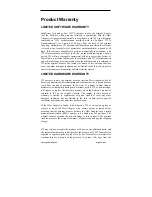
LSI Logic Corporation
Page 39 of 56
Up to 64
VLANs
First Adapter
Second Adapter
Third Adapter
Fourth Adapter
1
/etc/vlan
.alt0
/etc/vlan
.alt1
/etc/vlan
.alt2
/etc/vlan
.alt3
2
/etc/vlan
.alt100
/etc/vlan
.alt101
/etc/vlan
.alt102
/etc/vlan
.alt103
3
/etc/vlan
.alt200
/etc/vlan
.alt201
/etc/vlan
.alt202
/etc/vlan
.alt203
...
64
/etc/vlan
.alt6300
/etc/vlan
.alt6301
/etc/vlan
.alt6302
/etc/vlan
.alt6303
Table 11: Creating the /etc/vlan.alt<num> files
5. Place the appropriate VLAN ID tag into the
vlan.alt
<num>
file(s).
Each VLAN must be assigned a unique identification number. Even
though the maximum number of VLANs that can be configured on each
adapter is 64, any particular VLAN can be assigned an identification
number between 1 and 4094. The VLAN tagging format follows the
guidance provided in IEEE 802.1Q-1998.
The VLAN identifier numbers must be placed into each appropriate
vlan.alt
<num
>
file to which the adapter is a member.
Example:
Consider a server with a single adapter. The server is a
member of two VLANs, with VLAN identifiers 383 and 777. The
contents of the first file,
/etc/vlan.alt0
, would be "383" and the
contents of the second file
,
/etc/vlan.alt100
, would be "777".
Use your regular text editor to put the VLAN identifier number into the
appropriate
vlan.alt
<num>
file. Be certain that there are no spaces,
blank lines, or extra characters. The identifier can be entered in decimal
(e.g. 383), octal (e.g. 0577), or hexadecimal (e.g. 0x17F) format.
If you are finished with all optional configurations, reboot the system.
Changes to the optional configuration parameters (VLAN, Jumbo Frame, or
Dual Homing) do not take effect until you reboot the system. If you will be
making changes to the other optional parameters during your configuration
session, you should wait to reboot until those changes are complete.
If you modify parameters and put the system into service before rebooting,
you may experience configuration problems.
Perform this command to reboot the system:
















































